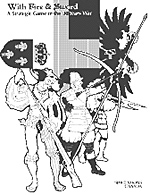 Players 2
Players 2
Playing time Unspecified (probably 4-6 hours for scenarios, 15-20 hours for the campaign)
Game period 1618-1648
Scale - turn 1 year
Scale - map 48 km (30 miles) / hex
Scale- unit unspecified (probably 2000 to 3000 soldiers per SP)
Components
box ziploc
1 map (includes tables)
1 eight page rulebook
200 counters
Counter Manifest
S pain (black/red) 5 leaders & 14 SPs
Empire (black/dk.red) 4 leaders & 13 SPs
Bavaria (black/purple) 5 leaders & 9 SPs
Saxony (black/pink) 2 leaders & 6 SPs
Sweden (black/green) 7 leaders & 13 SPs
Savoy (black/blue) 3 leaders & 8 SPs
Denmark (black/d.blue) 2 leaders & 7 SPs
United Provinces 2 leaders & 6 SPs (black/orange)
France (black/lt.blue) 3 leaders & 10 SPs
Bohemia (black/grey) 1 leader & 3 SPs
England (black/purple) 1 SP
4 markers (white) Revolt / Barren
SimCan says:
“In 1618, the political protests in Bohemia became the opening shots in a war that was eventually to engulf all of Western Europe in the bitter struggle of the great ruling families. For 3 decades the mercenary armies of Bourbon France and Hapsburg Spain fought for control of the European heartland. With Fire & Sword is a medium complexity strategic game of this period of turmoil. Three scenarios cover the major periods of the war and a campaign game links these ... to cover the entire three decades ... Leadership, sieges, plagues, and revolts all play a part in a game of maneuver and combat.”
Comments
Apropos of nothing, With Fire and Sword is also the title of a Polish novel about the Ukrainian rebellion of Bogdan Chmielnicki. The map is divided into about 20 nations, with a large blank area in the middle, as if the designer lost courage and stopped counting the tiny German principalities. Two comments: Anhalt is incorrectly called Halberstadt; and, included in the counter mix are three Bohemian SPs and one leader (Thurn-und-Taxis) which are not mentioned in the set up or reinforcements. I suggest treating them like Savoy/Anhalt units and putting them in Prague at the start. Each country receives Resource Points (RP) every turn, which are used to maintain armies. The game is completely driven by the RP schedule, which ensures that historical results. In particular, the Protestant player is quickly expelled from Bohemia, contrary to what often happens in 3W’s Holy Roman Empire (HRE). Units have unlimited movement factors and take more attrition the further they move. This may have strange effects as a 4 SP force can move 1000 hexes, lose 3 SP, and take an enemy capital. My suggestion is to limit movement to 18 MP, the maximum on the attrition table. The simulation is purely military: there are no diplomatic rules, nations enter the war at set dates, and there are no political rules either (except that Saxon and Bavarian troops go home if Spanish troops march into Bohemia and Eastern Germany). The word Elector does not appear in the rules, Mainz appears as Palatinate’s capital, and Trier and Cologne are not on the map. On the whole, the game is not very good, but since HRE has many problems and rule questions (and I am not even speaking of S&T’s 30 Years War), it is probably the only game on the period which is playable. It plays rather quickly (only winter attrition and VP calculations are tedious) and it gives a good idea of the three phases of the war.
Collectors Notes
Boone lists low, high and average prices of 2/12/6.75 at auction and 15/20/ 17.50 for sale.
Errata & Clarifications
The Terrain Effects Chart was replaced by a Terrain Key and rule 8.8. The Bohemians and Thurn start in Prague in the 1618 scenario (and the campaign game) and do not appear otherwise. For set up Breda is hex 0609 and Verdun is hex 0514. References to leaders in relation to a combat ratio should instead say combat differences. Mark’s capital is Arnsburg (1110). Control of a country is obtained by controlling all its cities but can be maintained by just a unit in the capital. How ever, as soon as one city falls to the other player, the country becomes disputed. Sacking is optional in sieges but required for siege assaults. And both are resolvable on the Siege Table. Only Saxon units can change sides. Units and leaders of other countries are eliminated if their country is taken over and the RPs are lost. In the campaign game Saxony will change to Coalition control when Sweden enters the war. Bernard reenters as a French leader with the first French units and 1636 on the Resource Chart should indicate 9 French SPs, rather than RPs.
Stephen Newberg says:
Peter Hollinger had a long standing interest in the 30 Years War and made it the topic of his first design for SimCan. There have been two or three more stratregic level games done on the topic since, bit I think Peter’s remains the best, as well as being his finest overall work. It is colorful, represents the history well, and manages to keep a very difficult and complex topic at a reasonable level of playability and realism. On the basis of this design, we hired Peter full time and he contributed a good deal to the firm over the next two years. He died of cancer at far too young an age, a couple of years ago, and is missed.
Back to Simulacrum Vol. 3 No. 2 Table of Contents
Back to Simulacrum List of Issues
Back to MagWeb Master Magazine List
© Copyright 2001 by Steambubble Graphics
This article appears in MagWeb (Magazine Web) on the Internet World Wide Web. Other military history articles and gaming articles are available at http://www.magweb.com